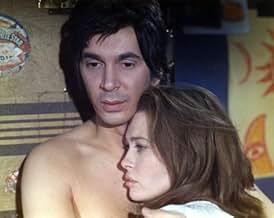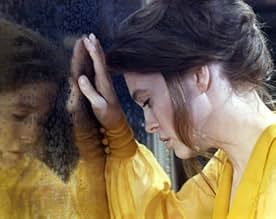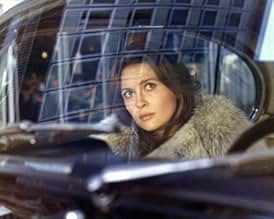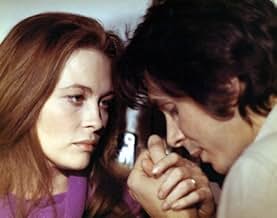La maison sous les arbres
- 1971
- Tous publics
- 1h 36min
NOTE IMDb
5,6/10
690
MA NOTE
Ajouter une intrigue dans votre langueJill's husband has been distant and troubled since they moved to Paris. He is pressured at work to engage in illegal activities but he refuses. Soon after, when their children disappear whil... Tout lireJill's husband has been distant and troubled since they moved to Paris. He is pressured at work to engage in illegal activities but he refuses. Soon after, when their children disappear while in Jill's care, her mental health is questioned.Jill's husband has been distant and troubled since they moved to Paris. He is pressured at work to engage in illegal activities but he refuses. Soon after, when their children disappear while in Jill's care, her mental health is questioned.
- Réalisation
- Scénario
- Casting principal
Michele Lourie
- Cathy
- (as Michèle Lourie)
Michel Charrel
- Petit rôle
- (non crédité)
Avis à la une
Arty, moody, stylized, slow thriller is also a love letter to Faye Dunaway's extraordinary, sensuous face. Has a similar vibe to the later "Don't Look Now" (just substitute Paris for Venice). Well-made, but it does require patience, and the story does not really receive full closure. **1/2 out of 4.
Of all the misguided choices Faye Dunaway made in her film career after co-starring in the 1967 hit "Bonnie and Clyde", this French-Italian co-production from director René Clément may be the most perplexing. An adaptation of Arthur Cavanaugh's novel "The Children Are Gone", this kidnapping drama set in Paris looks mournfully chic in gauzy autumnal colors but rarely comes together. Bickering American couple from Laurel Canyon--now apartment-dwellers in Paris for the past two years while the husband writes a book--are thrown into turmoil when their two kids disappear while on an outing in the wife's care. Dunaway is supposed to be something of a dotty, unreliable flibbertigibbet, a child-woman acting out her whims who needs psychiatric help. It's a faintly ridiculous role, too much and yet not enough for any actress to make sense out of. The villains (who are strong-arming the husband into some nefarious doings) are ill-defined nasties who arrive on the scene to portentous music on the soundtrack (in the old days, the man would have had a mustache to twirl at one end). Released under a different title in just about every country it played--including France, where it was shown as "La maison sous les arbres" ("The House Under the Trees")--it's a film that goes nowhere...and takes its time going nowhere. *1/2 from ****
From 1959 onwards (and with the success of "purple noon" (Ripley's first version),Clement wanted to become the French Hitchcock.He followed the rules quite well with the follow-up "les félins" then everything went wrong.After casting Jane Fonda ("les félins") he hired American stars for every "thriller" he made:Bronson,Ryan,Vaughn and here Dunaway.Why American stars by the way?They were all dubbed (with the exception of Fonda)for everybody cannot be Jodie Foster for that matter.
"La maison sous les arbres" is a would be suspenseful movie with heavy pretensions:a big set-up,where poor Dunaway is caught like a fly in a cobweb :her children are kidnapped and "they "keep them in... (well,check the title;it means "the house under the trees") No cigar ,and not even close.
"La maison sous les arbres" is a would be suspenseful movie with heavy pretensions:a big set-up,where poor Dunaway is caught like a fly in a cobweb :her children are kidnapped and "they "keep them in... (well,check the title;it means "the house under the trees") No cigar ,and not even close.
This gem may require a bit more patience than your average thriller, but its charms are plentiful and more often subtle than not. Director René Clément (1913-96) delivers an entrancing melodrama, highlighted by the ever-beautiful Faye Dunaway, who gives a tremendous performance as a mother in peril. Indeed, it's hard to imagine a better presentation of such a classic (or cliched) trope: Dunaway mixes her caught-in-the-middle Evelyn of "Chinatown" (1974) with the plucky Kathy of "Three Days of the Condor" (1975). It's unusual to see the actor portrayed as a loving mother (one exception being the great 1988 film "Burning Secret"), but her scenes with young Patrick are very believable (at the expense of so many other scenes - especially those with the enigmatic daughter Cathy). Even that little apartment the family occupies is very realistic too. They move around the place like they really live there.
Clément shows us a beautiful, but decidedly un-touristy side of Paris. The film, shot by Andréas Winding, who lensed Clément's previous "Rider on the Rain" (1970) and Jacques Tati's "Playtime" (1967), looks beautiful: soft focuses throughout, with Faye looking lovely, fading into dark, hazy, almost hallucinogenic settings. It's unclear why Faye and family are in Paris in the first place, but these outsiders inhabit their giallo with all the baggage that comes with strangers in a strange place. This film never quite goes giallo - despite its Italian title - but it comes close. The elliptical script was written by the actor/writer Daniel Boulanger (a writer of two segments of the 1967 Edgar Allan Poe omnibus film "Spirits of the Dead"), with the apparently uncredited Ring Lardner, Jr., who had previously scripted Robert Altman's "M.A.S.H." (1970) and was probably responsible for the convincing English dialog heard here (his credits in film noir are especially notable here).
It is a classic Hitchcockian situation, where a MacGuffin (in this case, a vague threat of "industrial espionage") drives the action. That action, the kidnapping of the children - which the script threatens mercilessly before the film's halfway point, when the kids finally disappear - comes, of course, from Hitchcock's "The Man Who Knew Too Much" (1956). But it's hard to see Faye Dunaway as a Hitchcock "blonde" or any one of the Master's female leads (only Marnie comes close). She comes from a generation of women Hitchcock could probably not have realistically directed or, really, even properly understood.
There are, however, a number of other film classics are referenced here as well, most notably "Gaslight" (1940 and 1944) and "Rosemary's Baby" (1968). These two references alone make Phillipe (a sexy Frank Langella) suspect; however, they also go to great length to address the painful wrongs society does to women in general and mothers in particular. The jolt, watching the film nearly five decades later, is seeing Jill (Faye Dunaway) taking the moral, public and even legal blame for the disappearance of her children. Once the kids are gone, Jill enters a Kafka nightmare that this film evokes in Wellesian images from the fantastic 1963 film adaptation of "The Trial."
The "brilliant" Phillipe's confusing involvement with "The Organization" also recalls Patricia Highsmith's "Ripley's Game," which is odd as that novel wasn't written for another three years (Wim Wenders filmed the 1974 book as "The American Friend" in 1977 and Liliana Cavani filmed it, beautifully again, in 2002). It's notable that Highsmith's first novel, "Strangers on a Train," was filmed by Hitchcock in 1951 while the novelist's celebrated "The Talented Mr. Ripley" was first filmed by Clément in 1960 as "Plein Soleil" (a.k.a. "Purple Noon" - also with Maurice Ronet, who gets only one brief scene here). It's not inconceivable that the talented Ms. Highsmith was inspired by this film to craft her terrific (and more logically worked out) "Ripley's Game."
The sheer number of beautiful staircases Clément shoots here also suggests the classic woman-in-peril noir "The Spiral Staircase" (1946): Jill's loving mother is "muted" here by her pre-figured criminality and her gaslighted "weak and imperfect" motherhood makes her an absolutely perfect potential victim. She can neither satisfy her husband (!) nor successfully protect her children. Well, it is early 70s French provincial after all. One staircase in particular here actually prefigures another famous staircase seen two years later in William Friedkin's "The Exorcist."
The lush orchestral score is by the renowned French singer Gilbert Bécaud (1927-2001), best known today as the writer of "What Now My Love" (covered by both Elvis Presley and Frank Sinatra) and "Let it Be Me" and co-writer of Neil Diamond's "Love on the Rocks" and "September Morn." Bécaud's main theme is a melodic piece that traffics appropriately in both playful childlike wistfulness and melancholy adult malaise. The tension cue that plays over the children's abduction is an eerie Morricone-esque minimalist piece that perfectly reflects a mind on the brink.
As far as the English dub on the 2016 Golem Video DVD I watched, the voices are so badly recorded it sounds as though they were doing it in someone's kitchen or bathroom. At times I couldn't figure out if Ms. Dunaway was dubbing herself or someone else was - or both. And all of the male voices sounded like no one other than Gene Wilder, who made a name for himself as Willy Wonka the year this film was released.
Oddly, this movie is known under many titles, few of which make much sense. Only the source novel's boring title seems reasonable, "The Children Are Gone." Not exactly thrilling, though, is it? So, how about the American title, "The Deadly Trap?" What was the trap? Phillipe's unexplained web of whatever? The French title, "The House by the Trees," sounds exciting - but it only makes sense toward the very end and only for a few brief moments. Then there's the Italian title, "The only clue: a yellow scarf," which is, umm, true but not as exciting as something like "The Amazon with the Scarf of Fire" or something baroquely giallo like that.
Still, the film is a worthy and intoxicating European thriller. It follows a classic dream/nightmare logic that makes it a worthy contender among such kidnap classics as "High and Low" (1963), "Séance on a Wet Afternoon" (1964) and "Bunny Lake is Missing" (1965) and goes some way to informing the giallo classic "Who Saw Her Die" (1972). There are great subtle touches here, notably Barbara Parkins' lovely performance as the significantly named "Cyn," the odd Michele Lourie playing the utterly inscrutable Cathy and the strange ending where a child's drawing is either malevolent or the happy ending that seems intended. All worth watching...
Clément shows us a beautiful, but decidedly un-touristy side of Paris. The film, shot by Andréas Winding, who lensed Clément's previous "Rider on the Rain" (1970) and Jacques Tati's "Playtime" (1967), looks beautiful: soft focuses throughout, with Faye looking lovely, fading into dark, hazy, almost hallucinogenic settings. It's unclear why Faye and family are in Paris in the first place, but these outsiders inhabit their giallo with all the baggage that comes with strangers in a strange place. This film never quite goes giallo - despite its Italian title - but it comes close. The elliptical script was written by the actor/writer Daniel Boulanger (a writer of two segments of the 1967 Edgar Allan Poe omnibus film "Spirits of the Dead"), with the apparently uncredited Ring Lardner, Jr., who had previously scripted Robert Altman's "M.A.S.H." (1970) and was probably responsible for the convincing English dialog heard here (his credits in film noir are especially notable here).
It is a classic Hitchcockian situation, where a MacGuffin (in this case, a vague threat of "industrial espionage") drives the action. That action, the kidnapping of the children - which the script threatens mercilessly before the film's halfway point, when the kids finally disappear - comes, of course, from Hitchcock's "The Man Who Knew Too Much" (1956). But it's hard to see Faye Dunaway as a Hitchcock "blonde" or any one of the Master's female leads (only Marnie comes close). She comes from a generation of women Hitchcock could probably not have realistically directed or, really, even properly understood.
There are, however, a number of other film classics are referenced here as well, most notably "Gaslight" (1940 and 1944) and "Rosemary's Baby" (1968). These two references alone make Phillipe (a sexy Frank Langella) suspect; however, they also go to great length to address the painful wrongs society does to women in general and mothers in particular. The jolt, watching the film nearly five decades later, is seeing Jill (Faye Dunaway) taking the moral, public and even legal blame for the disappearance of her children. Once the kids are gone, Jill enters a Kafka nightmare that this film evokes in Wellesian images from the fantastic 1963 film adaptation of "The Trial."
The "brilliant" Phillipe's confusing involvement with "The Organization" also recalls Patricia Highsmith's "Ripley's Game," which is odd as that novel wasn't written for another three years (Wim Wenders filmed the 1974 book as "The American Friend" in 1977 and Liliana Cavani filmed it, beautifully again, in 2002). It's notable that Highsmith's first novel, "Strangers on a Train," was filmed by Hitchcock in 1951 while the novelist's celebrated "The Talented Mr. Ripley" was first filmed by Clément in 1960 as "Plein Soleil" (a.k.a. "Purple Noon" - also with Maurice Ronet, who gets only one brief scene here). It's not inconceivable that the talented Ms. Highsmith was inspired by this film to craft her terrific (and more logically worked out) "Ripley's Game."
The sheer number of beautiful staircases Clément shoots here also suggests the classic woman-in-peril noir "The Spiral Staircase" (1946): Jill's loving mother is "muted" here by her pre-figured criminality and her gaslighted "weak and imperfect" motherhood makes her an absolutely perfect potential victim. She can neither satisfy her husband (!) nor successfully protect her children. Well, it is early 70s French provincial after all. One staircase in particular here actually prefigures another famous staircase seen two years later in William Friedkin's "The Exorcist."
The lush orchestral score is by the renowned French singer Gilbert Bécaud (1927-2001), best known today as the writer of "What Now My Love" (covered by both Elvis Presley and Frank Sinatra) and "Let it Be Me" and co-writer of Neil Diamond's "Love on the Rocks" and "September Morn." Bécaud's main theme is a melodic piece that traffics appropriately in both playful childlike wistfulness and melancholy adult malaise. The tension cue that plays over the children's abduction is an eerie Morricone-esque minimalist piece that perfectly reflects a mind on the brink.
As far as the English dub on the 2016 Golem Video DVD I watched, the voices are so badly recorded it sounds as though they were doing it in someone's kitchen or bathroom. At times I couldn't figure out if Ms. Dunaway was dubbing herself or someone else was - or both. And all of the male voices sounded like no one other than Gene Wilder, who made a name for himself as Willy Wonka the year this film was released.
Oddly, this movie is known under many titles, few of which make much sense. Only the source novel's boring title seems reasonable, "The Children Are Gone." Not exactly thrilling, though, is it? So, how about the American title, "The Deadly Trap?" What was the trap? Phillipe's unexplained web of whatever? The French title, "The House by the Trees," sounds exciting - but it only makes sense toward the very end and only for a few brief moments. Then there's the Italian title, "The only clue: a yellow scarf," which is, umm, true but not as exciting as something like "The Amazon with the Scarf of Fire" or something baroquely giallo like that.
Still, the film is a worthy and intoxicating European thriller. It follows a classic dream/nightmare logic that makes it a worthy contender among such kidnap classics as "High and Low" (1963), "Séance on a Wet Afternoon" (1964) and "Bunny Lake is Missing" (1965) and goes some way to informing the giallo classic "Who Saw Her Die" (1972). There are great subtle touches here, notably Barbara Parkins' lovely performance as the significantly named "Cyn," the odd Michele Lourie playing the utterly inscrutable Cathy and the strange ending where a child's drawing is either malevolent or the happy ending that seems intended. All worth watching...
Well this is an odd movie. Frank Langella and Faye Dunaway are names of no small renown, and given the sort of roles they're known for, it's hard to imagine them in pictures of any lesser quality. The premise of 'The deadly trap,' and the story as it unfolds, suggests a mildly disjointed narrative and uncertain truths as events unfold largely through Jill's perspective - a psychological thriller, to one extent or another. These are all positive indicators. However, it must be said that a drama attempting the angle that this does rather requires subtlety to bear fruit - and sadly, that is simply not the case here. The film is rendered with direly indelicate hands - blunt and direct, so bereft of tact as to come across as somewhat senselessly melodramatic. Frankly, this bears the air of a made-for-TV movie of the most gauche variety - and if that's not an unseemly portent, I don't know what is.
I claim no familiarity with the source material. I'm not entirely sure if the novel is more of an issue here, or the adapted screenplay, or René Clément's direction, but in almost every way there's a brutish inelegance present that severely dampens what enjoyment there is to be had. Sequencing and otherwise editing is curt, rough, and has the appearance of disorder. So it is as well for brusque dialogue, characters that don't seem fully developed, pointedly inelegant scene writing, and a plot that for all of the astounding heavy-handedness feels very forced. I would like to think that the feature was crafted so meticulously that every seeming fault was a conscious decision to echo and emphasize Jill's fractured mindset. Yet so much about 'The deadly trap' feels coarse and unpolished such that I have difficulty believing the same individuals that so crudely built the structure could have also purposefully filled it with more underhandedly refined detail. Those flaws come across, after all, as simply just flaws.
Langella and Dunaway have definitely proven themselves elsewhere, so I distinctly believe the writing and direction can be held responsible for coercing them and their fellow cast members into performances that are sorely lacking of subtlety or finesse. The very orchestration of every scene is marked with a pained sense of artifice on account of all the blemishes. Even the antagonists are left unnamed and ill-defined, a shadow of a shadow - a boogeyman of unseen power and influence. There are, most assuredly, some good ideas here, and for that I quite want to like this more than I do. Yet so poorly has the production been managed that the picture fails to have any impact, any real emotional heft or expected thrills. It's just unconvincing. It's unfortunate - this could have been good. I think it was rather close to being good. But ''The deadly trap' is middling as it presents, and teeters into a display of ham-handedness.
Alas. There are worse movies you could watch, by all means. Maybe viewers who are especial fans of someone in the cast will find this suitable enough - and generally speaking, everyone has their own opinion. But I regret to say I think this is too much of a mess to broadly recommend, and though it's not all bad, there's just no reason to go out of your way for it.
I claim no familiarity with the source material. I'm not entirely sure if the novel is more of an issue here, or the adapted screenplay, or René Clément's direction, but in almost every way there's a brutish inelegance present that severely dampens what enjoyment there is to be had. Sequencing and otherwise editing is curt, rough, and has the appearance of disorder. So it is as well for brusque dialogue, characters that don't seem fully developed, pointedly inelegant scene writing, and a plot that for all of the astounding heavy-handedness feels very forced. I would like to think that the feature was crafted so meticulously that every seeming fault was a conscious decision to echo and emphasize Jill's fractured mindset. Yet so much about 'The deadly trap' feels coarse and unpolished such that I have difficulty believing the same individuals that so crudely built the structure could have also purposefully filled it with more underhandedly refined detail. Those flaws come across, after all, as simply just flaws.
Langella and Dunaway have definitely proven themselves elsewhere, so I distinctly believe the writing and direction can be held responsible for coercing them and their fellow cast members into performances that are sorely lacking of subtlety or finesse. The very orchestration of every scene is marked with a pained sense of artifice on account of all the blemishes. Even the antagonists are left unnamed and ill-defined, a shadow of a shadow - a boogeyman of unseen power and influence. There are, most assuredly, some good ideas here, and for that I quite want to like this more than I do. Yet so poorly has the production been managed that the picture fails to have any impact, any real emotional heft or expected thrills. It's just unconvincing. It's unfortunate - this could have been good. I think it was rather close to being good. But ''The deadly trap' is middling as it presents, and teeters into a display of ham-handedness.
Alas. There are worse movies you could watch, by all means. Maybe viewers who are especial fans of someone in the cast will find this suitable enough - and generally speaking, everyone has their own opinion. But I regret to say I think this is too much of a mess to broadly recommend, and though it's not all bad, there's just no reason to go out of your way for it.
Le saviez-vous
- AnecdotesThe film has frequently been compared with Otto Preminger's 'Bunny Lake is Missing' (1965) and the slightly later picture 'Don't look Now' (1973) from director Nicolas Roeg.
- Versions alternativesU.S. release version re-titled 'The Deadly Trap' makes some cuts and reorders some early scenes - Philippe being threatened by his old employers is now one of the first, instead of coming about 15 minutes in. Kino's DVD/Blu-ray is the longer French version entitled 'La Maison Sous les Arbres.'
- ConnexionsReferenced in Massage Parlor Murders! (1973)
Meilleurs choix
Connectez-vous pour évaluer et suivre la liste de favoris afin de recevoir des recommandations personnalisées
- How long is The Deadly Trap?Alimenté par Alexa
Détails
- Date de sortie
- Pays d’origine
- Site officiel
- Langue
- Aussi connu sous le nom de
- The Deadly Trap
- Lieux de tournage
- Sociétés de production
- Voir plus de crédits d'entreprise sur IMDbPro
- Durée1 heure 36 minutes
- Mixage
- Rapport de forme
- 1.66 : 1
Contribuer à cette page
Suggérer une modification ou ajouter du contenu manquant




























